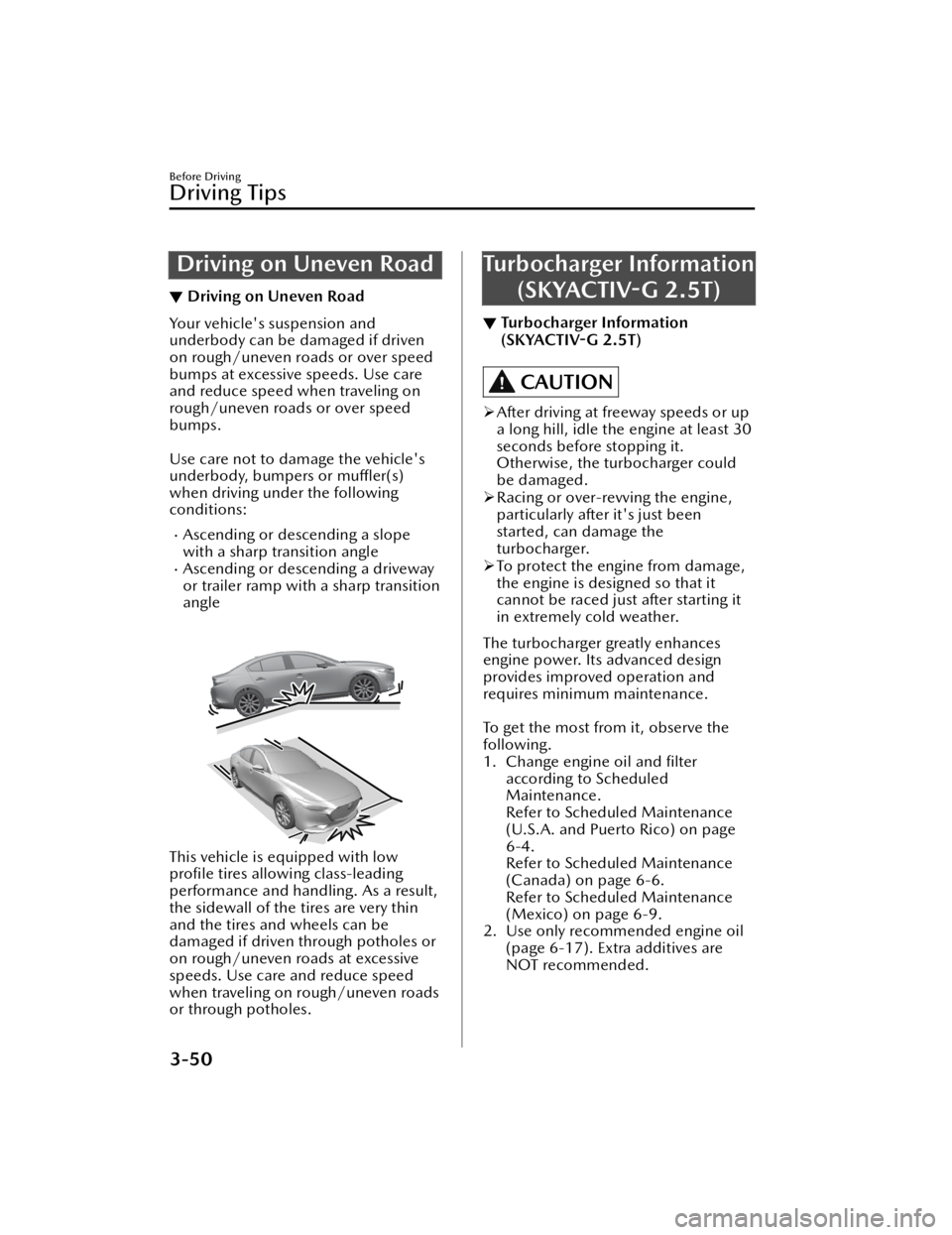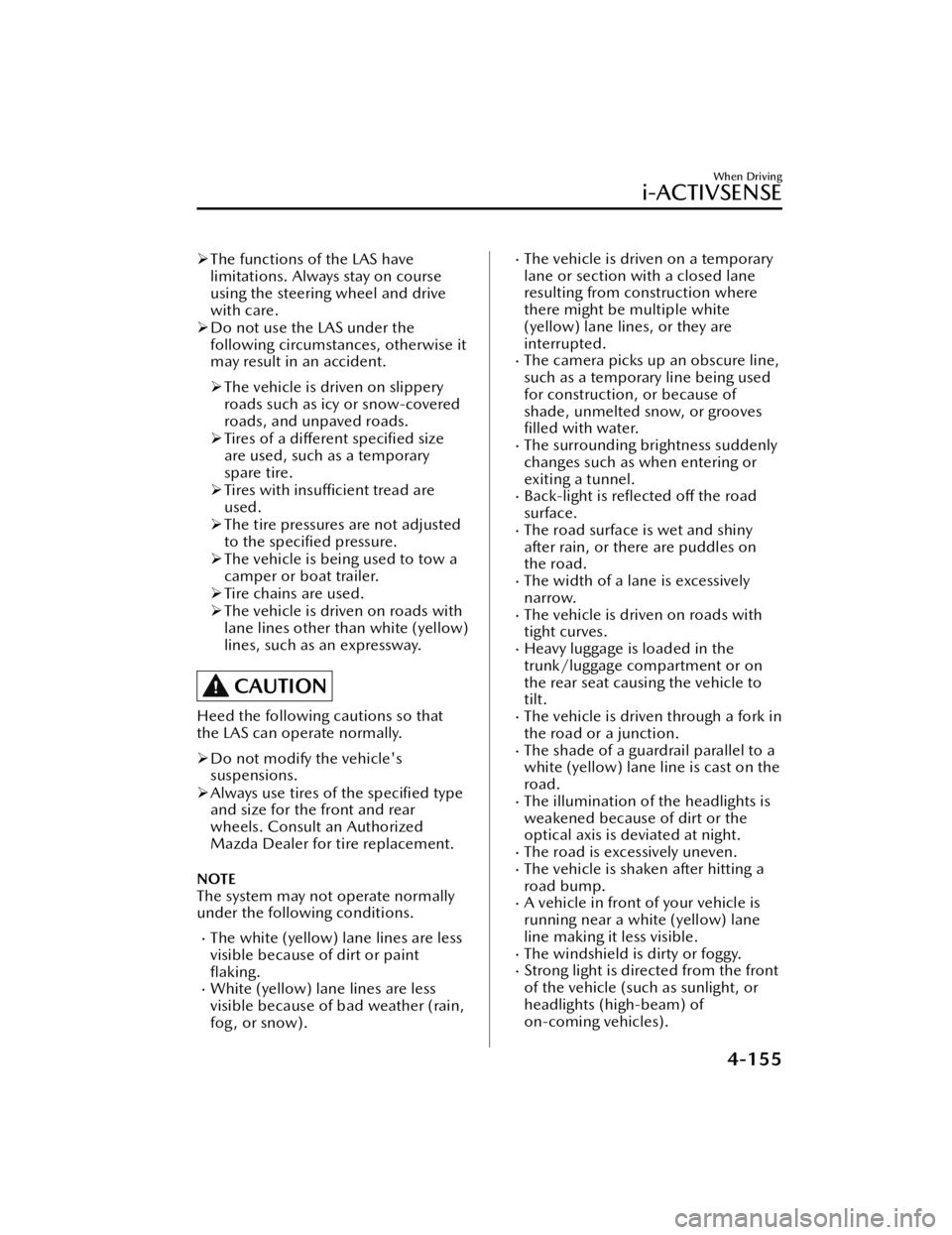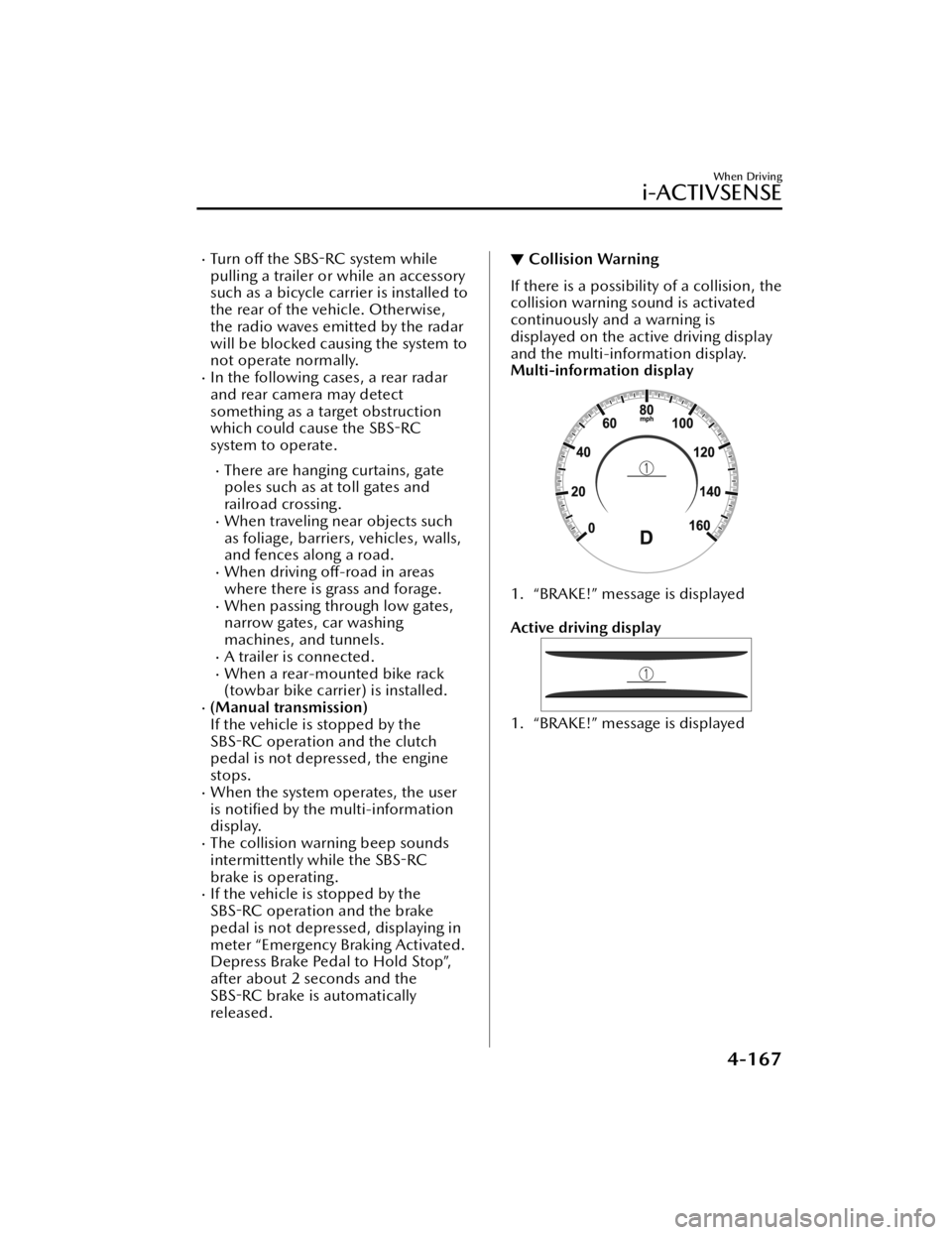trailer MAZDA MODEL 3 HATCHBACK 2021 Owners Manual
[x] Cancel search | Manufacturer: MAZDA, Model Year: 2021, Model line: MODEL 3 HATCHBACK, Model: MAZDA MODEL 3 HATCHBACK 2021Pages: 612, PDF Size: 89.06 MB
Page 91 of 612

3Before Driving
Use of various features, including keys, doors, mirrors and
windows.
Keys........................................ 3-2 Keys...................................... 3-2
Keyless Entry System...............3-4
Advanced Keyless Entry
System.....................................3-9 Advanced Keyless Entry
System
*................................. 3-9
Operational Range...............3-10
Doors and Locks..................... 3-11 Door Locks.......................... 3-11
Liftgate/Trunk Lid.................3-19
Inside Trunk Release Lever (4-
door)
*................................. 3-24
Fuel and Emission................... 3-25 Fuel and Engine Exhaust
Precautions......................... 3-25
Fuel-Filler Lid and Cap..........3-27
Mirrors.................................. 3-30 Mirrors................................3-30
Windows............................... 3-34 Power Windows...................3-34
Moonroof*.......................... 3-37
Security System.......................3-40 Modi fication and Add-
On Equipment..................... 3-40
Immobilizer System..............3-40
Theft-Deterrent System
*........3-42
Driving Tips............................ 3-44 Break-In Period.................... 3-44
Saving Fuel and Protection of the
Environment........................ 3-44
Hazardous Driving............... 3-45
Floor Mat............................ 3-46
Rocking the Vehicle..............3-46
Winter Driving..................... 3-47
Driving In Flooded Area........3-49
Overloading........................ 3-49
Driving on Uneven Road.......3-50
Turbocharger Information
(SKYACTIV -G 2.5T).............. 3-50
Towing.................................. 3-51 Trailer Towing...................... 3-51
Recreational Towing............. 3-51
*Some models.3-1
Mazda3_8JM2-EA -20H_Edition1_new 2020-7-10 17:21:34
Page 140 of 612

Driving on Uneven Road
▼Driving on Uneven Road
Your vehicle's suspension and
underbody can be damaged if driven
on rough/uneven roads or over speed
bumps at excessive speeds. Use care
and reduce speed when traveling on
rough/uneven roads or over speed
bumps.
Use care not to damage the vehicle's
underbody, bumpers or
muffler(s)
when driving under the following
conditions:
Ascending or descending a slope
with a sharp transition angle
Ascending or descending a driveway
or trailer ramp with a sharp transition
angle
This vehicle is equipped with low
pro file tires allowing class-leading
performance and handling. As a result,
the sidewall of the tires are very thin
and the tires and wheels can be
damaged if driven through potholes or
on rough/uneven roads at excessive
speeds. Use care and reduce speed
when traveling on rough/uneven roads
or through potholes.
Turbocharger Information
(SKYACTIV -G 2.5T)
▼ Turbocharger Information
(SKYACTIV
-G 2.5T)
CAUTION
After driving at freeway speeds or up
a long hill, idle the engine at least 30
seconds before stopping it.
Otherwise, the turbocharger could
be damaged.
Racing or over-revving the engine,
particularly after it's just been
started, can damage the
turbocharger.
To protect the engine from damage,
the engine is designed so that it
cannot be raced just after starting it
in extremely cold weather.
The turbocharger greatly enhances
engine power. Its advanced design
provides improved operation and
requires minimum maintenance.
To get the most from it, observe the
following.
1. Change engine oil and filter
according to Scheduled
Maintenance.
Refer to Scheduled Maintenance
(U.S.A. and Puerto Rico) on page
6-4.
Refer to Scheduled Maintenance
(Canada) on page 6-6.
Refer to Scheduled Maintenance
(Mexico) on page 6-9.
2. Use only recommended engine oil (page 6-17). Extra additives are
NOT recommended.
Before Driving
Driving Tips
3-50
Mazda3_8JM2-EA -20H_Edition1_new 2020-7-10 17:21:34
Page 141 of 612

Tra i l e r To w i n g
▼Tra i l e r To w i n g
Yo u r M a z d a i s n o t d e
signed for towing.
Never tow a trailer with your Mazda.
Recreational Towing
▼ Recreational Towing
An example of "recreational towing" is
towing your vehicle behind a
motorhome.
The transmission is not designed for
towing this vehicle on all 4 wheels.
When doing recreational towing refer
to "Towing Description" (page 7-23)
and "Tiedown Hooks" (page 7-24)
and carefully follow the instructions.
Before Driving
Towing
3-51
Mazda3_8JM2-EA
-20H_Edition1_new 2020-7-10 17:21:34
Page 240 of 612

When there is a difference in the
height between your driving lane
and the adjacent lane.
Directly after the BSM system
becomes operable by changing the
setting.
If the road width is extremely
narrow, vehicles two lanes over may
be detected. The detection area of
the rear side radar sensor is set
according to the road width of
expressways.
The BSM warning indicator light may
turn on and the vehicle detection
screen may be displayed in the
display in reaction to stationary
objects (guardrails, tunnels,
sidewalls, and parked vehicles) on
the road or the roadside.
1. Objects such as guardrails and concrete walls running alongside
the vehicle.
1. Places where the width between guardrails or walls on each side of
the vehicle narrows.
1. The walls at the entrance and exits of tunnels, turnouts.
A BSM warning indicator light may
fl ash or the warning beep may be
activated several times when making
a turn at a city intersection.
Tu r n off the BSM while pulling a
trailer or while an accessory such as a
bicycle carrier is installed to the rear
of the vehicle. Otherwise, the radar’s
radio waves will be blocked causing
the system to not operate normally.
In the following cases, it may be
diffi cult to view the
illumination/
fl ashing of the BSM warning
indicator lights equipped on the
door mirrors.
Snow or ice is adhering to the door
mirrors.
The front door glass is fogged or
covered in snow, frost or dirt.
When Driving
i-ACTIVSENSE
4-98
Mazda3_8JM2-EA -20H_Edition1_new 2020-7-10 17:21:34
Page 261 of 612

In the following cases, it may be
difficult to view the illumination/
fl ashing of the Blind Spot Monitoring
(BSM) warning indicator lights
equipped on the door mirrors.
Snow or ice adheres to the door
mirrors.
The front door glass is fogged or
covered in snow, frost or dirt.
Tu r n o ff the RCTA system while
pulling a trailer or while an accessory
such as a bicycle carrier is installed to
the rear of the vehicle. Otherwise,
the radio waves emitted by the radar
will be blocked causing the system to
not operate normally.
The rear side radar sensor of the
RCTA may be regulated under the
radio wave related laws of the
country where the vehicle is driven. If
this system is used abroad, it may be
necessary to turn o ff the system.
Refer to Rear Side Radar Sensor on
page 4-211.
▼ Canceling Operation of Rear Cross
Tra
ffic Alert (RCTA)
The RCTA can be set to inoperable.
(If only the RCTA is turned
off)
Refer to the Settings section in the
Mazda Connect Owner's Manual.
(If the RCTA is turned o ff by
operating the i-ACTIVSENSE OFF
switch)
Refer to i-ACTIVSENSE OFF Switch
on page 4-89.
NOTE
If the ignition is switched OFF while
you have canceled the system using the
i-ACTIVSENSE OFF switch, the system
is automatically enabled the next time
the ignition is switched ON. However,
if the system is canceled using the
personalization features, the system is
not automatically enabled.
When Driving
i-ACTIVSENSE
4-119
Mazda3_8JM2-EA -20H_Edition1_new 2020-7-10 17:21:34
Page 282 of 612

The TJA may not be able to detect a
vehicle ahead depending on the type
of vehicle ahead and its conditions,
the weather conditions, and the road
conditions. Additionally, the system
might be unable to decelerate
su fficiently if a vehicle ahead applies
the brakes suddenly, another vehicle
cuts into the driving lane, or the di fference in vehicle speed between
your vehicle and the vehicle ahead is
larger, which could result in an
accident. Check the surrounding
conditions and always drive carefully
while keeping a safe distance from
vehicles ahead and on-coming
vehicles.
For the purposes of safety, switch the
TJ A o ff when it is not being used.
Leaving the TJA turned on when it is
not in use is dangerous as it could
operate unexpectedly, resulting in an
accident.
Do not use the TJA under the
following conditions. Otherwise, it
may result in an accident.
General roads other than
expressways or highways (Driving
under these conditions using the TJA
is not possible.)
Roads with sharp curves and where
vehicle traffi c is heavy with
insuffi cient space between vehicles,
or roads where frequent and
repetitive acceleration and
deceleration occur (Driving under
these conditions using the TJA is not
possible). When entering and exiting
interchanges, service areas, and
parking areas of expressways (If you
exit an expressway while headway
control is in use, the vehicle ahead
will no longer be tracked and your
vehicle may accelerate to the set
speed).
Slippery roads such as icy or
snow-covered roads (Tires could spin
causing you to lose vehicle control,
or the stop hold control may not
operate.)
Long, descending slopes (to
maintain distance between vehicles,
the system automatically and
continuously applies the brakes
which could result in the loss of
brake power.)
Two-wheeled vehicles such as
motorcycles or bicycles are ahead.
(Automatic transmission vehicle)
Slopes with a steep gradient (The
vehicle ahead may not be detected
correctly, your vehicle may slip while
stopped by the stop hold control, or
it may accelerate suddenly after it
starts moving.)
Driving under bad weather
conditions (rain, fog , and snow).
The vehicle is driven on slippery
roads such as icy or snow -covered
roads and unpaved roads (Tires
could spin causing you to lose
vehicle control, or the stop hold
control may not operate.)
Tires of a di fferent specified size are
used, such as a temporary spare tire.
Tires with insu fficient tread are used.
The tire pressures are not adjusted to
the
speci fied pressure.
The vehicle is being used to tow a
camper or boat trailer.
Tire chains are used.
When Driving
i-ACTIVSENSE
4-140
Mazda3_8JM2-EA -20H_Edition1_new 2020-7-10 17:21:34
Page 297 of 612

The functions of the LAS have
limitations. Always stay on course
using the steering wheel and drive
with care.
Do not use the LAS under the
following circumstances, otherwise it
may result in an accident.
The vehicle is driven on slippery
roads such as icy or snow-covered
roads, and unpaved roads.
Tires of a
different
speci fied size
are used, such as a temporary
spare tire.
Tires with
insufficient tread are
used.
The tire pressures are not adjusted
to the
specified pressure.
The vehicle is being used to tow a
camper or boat trailer.
Tire chains are used.
The vehicle is driven on roads with
lane lines other than white (yellow)
lines, such as an expressway.
CAUTION
Heed the following cautions so that
the LAS can operate normally.
Do not modify the vehicle's
suspensions.
Always use tires of the speci fied type
and size for the front and rear
wheels. Consult an Authorized
Mazda Dealer for tire replacement.
NOTE
The system may not operate normally
under the following conditions.
The white (yellow) lane lines are less
visible because of dirt or paint
fl aking.
White (yellow) lane lines are less
visible because of bad weather (rain,
fog , or snow).
The vehicle is driven on a temporary
lane or section with a closed lane
resulting from construction where
there might be multiple white
(yellow) lane lines, or they are
interrupted.
The camera picks up an obscure line,
such as a temporary line being used
for construction, or because of
shade, unmelted snow, or grooves
filled with water.
The surrounding brightness suddenly
changes such as when entering or
exiting a tunnel.
Back-light is re flected off the road
surface.
The road surface is wet and shiny
after rain, or there are puddles on
the road.
The width of a lane is excessively
narrow.
The vehicle is driven on roads with
tight curves.
Heavy luggage is loaded in the
trunk/luggage compartment or on
the rear seat causing the vehicle to
tilt.
The vehicle is driven through a fork in
the road or a junction.
The shade of a guardrail parallel to a
white (yellow) lane line is cast on the
road.
The illumination of the headlights is
weakened because of dirt or the
optical axis is deviated at night.
The road is excessively uneven.The vehicle is shaken after hitting a
road bump.
A vehicle in front of your vehicle is
running near a white (yellow) lane
line making it less visible.
The windshield is dirty or foggy.Strong light is directed from the front
of the vehicle (such as sunlight, or
headlights (high-beam) of
on-coming vehicles).
When Driving
i-ACTIVSENSE
4-155
Mazda3_8JM2-EA -20H_Edition1_new 2020-7-10 17:21:34
Page 305 of 612

When traveling near objects such
as foliage, barriers, vehicles, walls,
and fences along a road.
When driving off-road in areas
where there is grass and forage.
When passing through low gates,
narrow gates, car washing
machines, and tunnels.
A trailer is connected.An exterior accessory such as a
bicycle carrier is installed around a
rear ultrasonic sensor.
(Manual transmission)
If the vehicle is stopped by the SBS -R
operation and the clutch pedal is not
depressed, the engine stops.
When the system operates, the user
is noti fied by the multi-information
display.
The collision warning beep sounds
intermittently while the SBS -R brake
is operating.
If the vehicle is stopped by the SBS -R
operation and the brake pedal is not
depressed, displaying in meter
“Emergency Braking Activated.
Depress Brake Pedal to Hold Stop”,
after about 2 seconds and the SBS -R
brake is automatically released.
Tu r n o ff the SBS-R system while
pulling a trailer or while an accessory
such as a bicycle carrier is installed to
the rear of the vehicle.
▼ Collision Warning
If there is a possibility of a collision, the
collision warning sound is activated
continuously and a warning is
displayed on the active driving display
and the multi-information display.
Multi-information display
1. “BRAKE!” message is displayed
Active driving display
1. “BRAKE!” message is displayed
▼Stopping the Smart Brake Support
[Rear] (SBS
-R) System Operation
The SBS -R can be changed to
inoperable.
Refer to the Settings section in the
Mazda Connect Owner's Manual.
When the SBS -R is canceled, the SBS
OFF indicator light turns on.
NOTE
When the SBS -R is canceled, the Smart
Brake Support [Rear Crossing]
(SBS -RC) is also canceled.
When Driving
i-ACTIVSENSE
4-163
Mazda3_8JM2-EA -20H_Edition1_new 2020-7-10 17:21:34
Page 309 of 612

Tu r n off the SBS-RC system while
pulling a trailer or while an accessory
such as a bicycle carrier is installed to
the rear of the vehicle. Otherwise,
the radio waves emitted by the radar
will be blocked causing the system to
not operate normally.
In the following cases, a rear radar
and rear camera may detect
something as a target obstruction
which could cause the SBS -RC
system to operate.
There are hanging curtains, gate
poles such as at toll gates and
railroad crossing.
When traveling near objects such
as foliage, barriers, vehicles, walls,
and fences along a road.
When driving off -road in areas
where there is grass and forage.
When passing through low gates,
narrow gates, car washing
machines, and tunnels.
A trailer is connected.When a rear-mounted bike rack
(towbar bike carrier) is installed.
(Manual transmission)
If the vehicle is stopped by the
SBS- RC operation and the clutch
pedal is not depressed, the engine
stops.
When the system operates, the user
is noti fied by the multi-information
display.
The collision warning beep sounds
intermittently while the SBS -RC
brake is operating.
If the vehicle is stopped by the
SBS- RC operation and the brake
pedal is not depressed, displaying in
meter “Emergency Braking Activated.
Depress Brake Pedal to Hold Stop”,
after about 2 seconds and the
SBS- RC brake is automatically
released.
▼ Collision Warning
If there is a possibility of a collision, the
collision warning sound is activated
continuously and a warning is
displayed on the active driving display
and the multi-information display.
Multi-information display
1. “BRAKE!” message is displayed
Active driving display
1. “BRAKE!” message is displayed
When Driving
i-ACTIVSENSE
4-167
Mazda3_8JM2-EA
-20H_Edition1_new 2020-7-10 17:21:34
Page 348 of 612

Tire chains or a temporary spare
tire is installed.
The vehicle ahead has a special
shape. For example, a vehicle
towing a trailer house or a boat, or
a vehicle carrier carrying a vehicle
with its front pointed rearward.
If the Forward Sensing Camera (FSC)
cannot operate normally due to rain,
backlight, or fog, the system
functions related to the Forward
Sensing Camera (FSC) are
temporarily stopped and the
following warning lights turn on.
However, this does not indicate a
malfunction.
High Beam Control System (HBC)
warning indication/warning light
(amber)
i-ACTIVSENSE warning indication/
warning light
If the Forward Sensing Camera (FSC)
cannot operate normally due to high
temperatures, the system functions
related to the Forward Sensing
Camera (FSC) are temporarily
stopped and the following warning
lights turn on. However, this does
not indicate a malfunction. Cool
down the area around the Forward
Sensing Camera (FSC) such as by
turning on the air conditioner.
High Beam Control System (HBC)
warning indication/warning light
(amber)
i-ACTIVSENSE warning indication/
warning light
If the Forward Sensing Camera (FSC)
detects that the windshield is dirty or
foggy, the system functions related to
the Forward Sensing Camera (FSC)
are temporarily stopped and the
following warning lights turn on.
However, this does not indicate a
problem. Remove the dirt from the
windshield or press the defroster
switch and defog the windshield.
High Beam Control System (HBC)
warning indication/warning light
(amber)
i-ACTIVSENSE warning indication/
warning light
If there are recognizable cracks or
damage caused by flying gravel or
debris on the windshield, always
have the windshield replaced.
Consult an Authorized Mazda Dealer
for replacement.
The Forward Sensing Camera (FSC)
recognizes pedestrians when all of
the following conditions are met:
The height of a pedestrian is about
1 to 2 meters.
An outline such as the head, both
shoulders, or the legs can be
determined.
In the following cases, the Forward
Sensing Camera (FSC) may not be
able to detect target objects
correctly:
Multiple pedestrians are walking,
or there are groups of people.
A pedestrian is close to a separate
object.
A pedestrian is crouching , lying , or
slouching.
A pedestrian suddenly jumps into
the road right in front of the
vehicle.
A pedestrian opens an umbrella, or
is carrying large baggage or
articles.
When Driving
i-ACTIVSENSE
4-206
Mazda3_8JM2-EA -20H_Edition1_new 2020-7-10 17:21:34